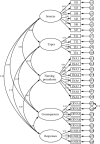Development and Evaluation of Psychometric Properties of a Chinese Version Questionnaire for Measuring Emergency Nursing Interruptions
- PMID: 40224780
- PMCID: PMC11919178
- DOI: 10.1155/2024/8750135
Development and Evaluation of Psychometric Properties of a Chinese Version Questionnaire for Measuring Emergency Nursing Interruptions
Abstract
Nursing interruptions occur frequently and often have adverse outcomes, threatening patient safety. Emergency departments have a high incidence of nursing interruptions owing to the concentration of critically ill patients and frequent emergencies. Current research mainly focuses on large hospitals and uses observation and interview methods. Therefore, there is a need to develop tools for measuring emergency nursing interruptions. This study develops a survey questionnaire on emergency nursing interruptions. It tests its validity and reliability by building on the conceptual framework of emergency nursing interruption proposed in the literature. Specifically, we develop a test version of the emergency nursing interruption survey questionnaire using a Delphi expert inquiry and preinvestigation. We selected 1047 emergency nurses in 22 provinces and autonomous regions of China to participate in the survey by completing the questionnaire between June and July 2023 to evaluate the validity and reliability of the questionnaire. The final questionnaire comprised 26 items across 5 dimensions-sources, types, interrupted nursing activities, consequences of interrupted nursing activities, and management of nursing interruptions. The content validity indexes were 0.948 at scale level and 0.842-1.000 at item level. We used exploratory factor analysis (EFA) to extract five common factors with a cumulative variance contribution rate of 66.550%. The results of the confirmatory factor analysis (CFA) demonstrated a good model fit. Cronbach's α coefficient of the questionnaire was 0.912, split-half reliability was 0.846, and the retest reliability calculated using the intraclass correlation coefficient was 0.915. To ensure the structural validity of the scales, EFA and CFA were conducted using two different datasets. Thus, the questionnaire showed good validity and reliability and can be used to evaluate how nurses understand emergency nursing interruptions.
Keywords: emergency department; nursing interruptions; patient safety; questionnaire; reliability; validity.
Copyright © 2024 Tao Lin et al.
Conflict of interest statement
The authors declare no conflicts of interest.
Figures


Similar articles
-
Reliability and validity of the Chinese version of the Information Security Attitude Questionnaire for nurses.Nurs Open. 2024 Jun;11(6):e2203. doi: 10.1002/nop2.2203. Nurs Open. 2024. PMID: 38845463 Free PMC article.
-
Development and psychometric testing of the Knowledge, Attitudes and Practices (KAP) questionnaire among student Tuberculosis (TB) Patients (STBP-KAPQ) in China.BMC Infect Dis. 2018 May 8;18(1):213. doi: 10.1186/s12879-018-3122-9. BMC Infect Dis. 2018. PMID: 29739363 Free PMC article.
-
Psychometric properties of the Chinese mainland version of the Palliative Care Spiritual Care Competency Scale (PCSCCS-M) in nursing: a cross-sectional study.BMC Palliat Care. 2019 Mar 8;18(1):27. doi: 10.1186/s12904-019-0409-6. BMC Palliat Care. 2019. PMID: 30849968 Free PMC article.
-
Preparation and Reliability and Validity Test of the Questionnaire on the Maintenance of Intravenous Catheter in ICU Nurses' Center.Nurs Open. 2025 Feb;12(2):e70145. doi: 10.1002/nop2.70145. Nurs Open. 2025. PMID: 39899244 Free PMC article.
-
Evaluation of reliability and validity regarding the Chinese version of Critical Cultural Competence Scale for clinical nurses.Zhong Nan Da Xue Xue Bao Yi Xue Ban. 2022 Oct 28;47(10):1425-1434. doi: 10.11817/j.issn.1672-7347.2022.210695. Zhong Nan Da Xue Xue Bao Yi Xue Ban. 2022. PMID: 36411694 Free PMC article. Clinical Trial. Chinese, English.
References
-
- Han X. Y., Zhang C. H., Wu C. C. Investigation and Analysis of Nursing Interruptions in the Operating Room and Nurses’ Feelings. Journal of Advanced Nursing . 2022;37(24):2278–2282. doi: 10.16821/j.cnki.hsjx.2022.24.016. - DOI
-
- Sun F. P. Study on the Status Quo and Intervention Management of Nursing Interruption in the Emergency Department. Modern Hospital . 2021;21(4):521–525. doi: 10.3969/J.issn.1671-332X.2021.04.009. - DOI
-
- Gan G., Wang S., Dong X. Q., Zhang X. H., Liu M., Xie J. F. Content Development of Nursing Interruptions Management Training for Clinical Nurses. Chinese Nursing Management . 2023;23(06):899–903. doi: 10.3969/j.issn.1672-1756.2023.06.019. - DOI
-
- Hu L. L., Sun L., Liu H. Y., Han X. Y. Interventions Occurring During the Starting Phase of Hematology: A Direct Observational Study. Journal of Nursing Science . 2023;38(02):39–43. doi: 10.3870/j.issn.1001-4152.2023.02.039. - DOI
MeSH terms
LinkOut - more resources
Full Text Sources

